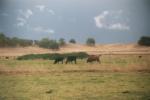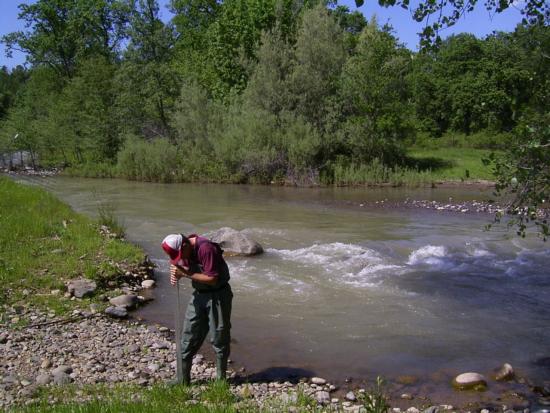Rainbow Trout Distribution and Habitat Use in Rangeland Streams
-
IssueMany California rangeland watersheds experience extensive livestock use, and many landowners divert stream water for pasture irrigation. Fish population declines and habitat alteration across northern California watersheds have resulted in the listing of species under the Endangered Species Act, and the implementation of water quality strategies for impaired waterbodies. These events highlight the importance of species recovery and habitat restoration efforts, and bring the potential impacts of agricultural practices under increasing scrutiny.

-
Objectives
Many California rangeland watersheds experience extensive livestock use, and many landowners divert stream water for pasture irrigation. Our goal was to provide landowners and managers with current baseline information about the conditions in which fish were found in a typical rangeland stream in the Central Valley.
-
Research Activities
We sampled fish in pools located on tributaries of Cow Creek, in the northern Sacramento Valley, California, and related fish distribution and habitat use to environmental factors across the agricultural growing seasons of 2003-2005. We sampled fish and habitat in irrigation ditches and adjacent mainstem reaches of Cow Creek in 2006.
-
Results
Our 2003 study looked at fish distribution in the Cow Creek watershed across the spring-summer-fall season, roughly correlated with the agricultural growing season and the use of stream water for irrigation. The study suggests that fish species distribution in pools in rangeland streams varies across the growing season, and is correlated with factors such as stream temperature and pool depth. Lower elevation pools may provide habitat for cold-water species such as rainbow trout/steelhead and salmon in spring and fall, but not in mid-summer when pool temperatures increase. In contrast, higher elevation pools may provide cold-water fish habitat throughout the year. It is likely that rainbow trout/steelhead populations are limited by the stream area that is habitable in mid-summer, and that lengthening the part of the stream that is cold enough year-round to support cold-water species will allow populations to increase. We are currently analyzing data from subsequent years of the study.
-
Outcomes and Impacts
Our results provide a basis for the development and comparison of irrigation best management practices that may improve conditions for native fish in rangeland streams. Our results have been presented to agricultural producers, watershed groups, and at numerous fisheries conferences. Results are also available as open-source peer-review publications.
-
Photos
 Larry Forero, Livestock and Natural Resources Advisor, checks water transparency of Cow Creek in spring 2006. Photo by Lisa Thompson.
Larry Forero, Livestock and Natural Resources Advisor, checks water transparency of Cow Creek in spring 2006. Photo by Lisa Thompson. -
Supporting Information
Thompson, L.C., L. Forero, Y. Sado, and K.W. Tate. 2006. Impact of environmental factors on fish distribution assessed in rangeland streams. California Agriculture. 60(4):200-206. Download
-
Acknowledgements
This project was funded by the UC Division of Agriculture and Natural Resources.
-
For more information contact
Dr. Lisa C. Thompson
Wildlife, Fish, & Conservation Biology Department
University of California, DavisEmail: lcthompson@ucdavis.edu
Phone: (530) 754-5732


